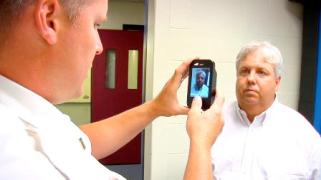“The technology is a game-changer,” McDonald said. “It’s going to enable officers to really get a handle on who the bad guys are, and make it more difficult for these bad guys to hide from us.”
*****
I really like technologies like this, because they piggy back on already available platforms that everyone is familiar with. Plus this is just neat. To be able to use your iPhone to capture electronic fingerprints, iris scans and photographs, and then send them into a massive database to tell if you have a criminal or not, is pretty damn cool.
This could also have application in the war. Biometrics were used in cities like Falujah in Iraq, to keep track of everyone coming in and out of check points. If you can put together a database of everyone’s identity in a population center, and you have iris/photo/finger print identification for each person, you can track people way better. It could also help out a country in determining the status of their population, and truly identifying people who are citizens so they could award them the services they deserve. We should be using these technologies more, if we want to separate the bad guys from the good guys.
Plus contractors and soldiers have access to iPhones, and many carry them.(I carry one on contracts) Or these smart phones could be purchased off the shelf for military units, and distributed that way. The phones come equipped with all the computing power and mobile apps available on the internet. Apple makes a great product, and they have fantastic support for that product. Devices like the MORIS just slip over the thing, and give it this capability. That is far better than re-inventing the wheel, and paying for that re-invention to get a product that will probably be less capable than what is currently available. –Matt
——————————————————————
‘IPhone on Steroids’ Gives Law Enforcement a Biometric Boost
Jun 25, 2010
By Russell Nichols
Plymouth County, Mass., Sheriff Joseph McDonald calls the county’s latest crime-fighting tool “an iPhone on steroids.”
A fitting description for the device, which he said enhances and strengthens the ability of law enforcement officers to identify suspects and retrieve their criminal records in seconds by capturing biometric data.
“The technology is a game-changer,” McDonald said. “It’s going to enable officers to really get a handle on who the bad guys are, and make it more difficult for these bad guys to hide from us.”
This month, Plymouth County became the first in the country to deploy the Mobile and Wireless Multi-Modal Biometric Offender Recognition and Information System (MORIS). The system is part of a national network, designed to help law enforcement agencies keep track of sex offenders, gang members, inmates and illegal aliens, said Sean Mullin, president of Plymouth-based Biometric Intelligence and Identification Technologies (BI2 Technologies), which developed MORIS in partnership with Apple.

